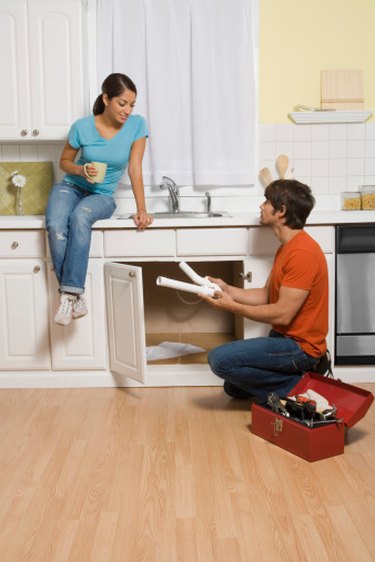Things You'll Need
Bucket
Rags
Slip-joint pliers
Safety goggles (optional)
Gloves (optional)

PVC sink traps frequently require disassembly for cleaning, particularly in heavily used kitchens. Fortunately, loosening and removing a PVC sink trap requires few tools and only beginner-level plumbing skills, and is one of the most effective ways to clear a clogged drain line. The components in common PVC sink traps connect with threaded compression fittings. These fittings create a seal between the separate parts via a plastic washer that compresses upon tightening. It's often possible to loosen compression nuts by hand; however, if parts are old or coated with buildup, you can use slip-joint pliers to gently loosen the connection.
Step 1
Open the under-sink cabinet's doors. Place a bucket directly beneath the PVC sink trap; traps hold water, which will inevitably spill once you loosen the trap. Scan the trap to find both of the trap's two compression nuts; the nuts are round, ribbed and attach vertically to the sink's drainpipe extension and horizontally to the drain line.
Video of the Day
Step 2
Wrap a rag around the the trap's uppermost compression nut, which is the nut that attaches to the sink's drainpipe extension, and grip the nut with one hand. Twist the nut counterclockwise to loosen it. Reposition the bucket if water spills onto the cabinet's base. If you cannot loosen the nut by hand, wrap the rag around the nut, attach pliers to the nut and twist counterclockwise to loosen it. Fully loosen the uppermost compression nut.
Step 3
Wrap a rag around the lower compression nut, which is the nut attached to the horizontal drainpipe, and attach pliers or grip the nut by hand. Twist the nut counterclockwise to loosen it. Reposition the bucket to catch water, if necessary.
Step 4
Slide the uppermost portion of the trap off the sink's extension pipe. Slide the lower portion of the trap off the horizontal drain line. Remove the trap from the under-sink cabinet for cleaning or replacement.
Warning
If your sink trap contains a mixture of standing water and drain-cleaning fluid, wear goggles and gloves to avoid chemical burns.
Video of the Day